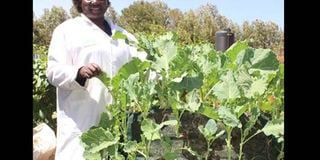Small space, big vegetable harvest

Hellen Gisare in her farm in Uasin Gishu where she grows vegetables in Ultra Violet treated sacks. The sacks are hardly affected by sun rays and tend to minimise wastage of water. PHOTO | STANLEY KIMUGE | NATION MEDIA GROUP
What you need to know:
- Hellen grows her crops in ultra-violet (UV) treated sacks specially designed for farming vegetables and other crops that do not have taproots.
- A single bag goes for Sh1,200, but one can get from Sh900 to Sh1,000 if they buy in bulk. All her sacks have 100 holes, each hosting a plant.
- Hellen begun urban farming in 2006 by planting vegetables in ordinary sacks.
- UV treatment means that they cannot be affected by sun rays like ordinary ones.
Long’enet village, off Eldoret-Ziwa Road in Uasin Gishu County, is currently dry and dusty, as many other places across the country following the dry weather.
The sweltering heat has scorched most of the crops on farms, including weeds.
However, on a quarter acre owned by Hellen Gisare, things are different. The farm hosting spinach, collard greens (sukuma wiki), strawberry, potatoes and onions has seemingly defied the bad weather.
Hellen grows her crops in ultra-violet (UV) treated sacks specially designed for farming vegetables and other crops that do not have taproots.
Her 12 bags that occupy about half of her quarter-acre enable her to save on water and space as she produces plenty food.
“I source the sacks from Thika. They last between 10 to 13 years. Ordinary sacks that are not UV treated last six months, get worn out easily and burn the crops,” says Hellen, adding the bags sizes are determined by number of crops they carry namely, 40, 80 and 100.
A single bag goes for Sh1,200, but one can get from Sh900 to Sh1,000 if they buy in bulk. All her sacks have 100 holes, each hosting a plant.
“Each sack takes eight wheelbarrows of soil, similar amount of manure (from cows, sheep and chicken and leaves mixed together), 3kg of pebbles, which I place at the base. I then add a bag of pure lime to reduce acidity. At the top of each sack, I put mulching grass,” she explains, adding the growing media stays for as long as a year before she changes them.
The farmer intercrops mainly sukuma wiki with spinach. “I plant cabbage and capsicum at the base of the sacks since they require good amount of water.”
MINIMISES WATER USE
The farmer, who draws water from a well she has drilled, says that the technique minimises water use.
“I water the plants every morning with 40 litres. During the dry weather, farmers can use waste water from the kitchen to water their crops,” says the teacher at Eldoret Central Secondary School, adding that diseases such as white flies and rust are some of the challenges she grapples with.
And depending on the season, she makes between Sh300 to Sh400 per sack every week, selling the vegetables to consumers and traders in her locality.
The farmer is also using old plastic buckets and tyres to grow the crops.
“Nothing should go to waste in our environment. I have turned the waste materials into farms,” says the mother of four, who notes that despite most farmers in the region having large farms, they do not grow vegetables but focus on wheat and maize, which gives her an edge.
Hellen begun urban farming in 2006 by planting vegetables in ordinary sacks. But the eight nylon sacks burnt the crops, prompting her to change to the new sacks following advise from an agronomist.
“It’s a good technique, especially for the youth or urban dwellers where land sizes are smaller.”
Benjamin Lagat, an agricultural officer in Uasin Gishu County, says the fact that the sacks are UV treated means that they cannot be affected by sun rays like ordinary ones.
“In case a farmer cannot access them, they can use sacks made from sisal or strong polythene sacks used in silage making process.”





